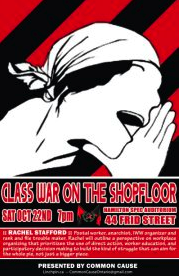Postal workers, sometimes known as 'posties' have been at the forefront of labour struggles this year. In addition to the well-publicized lockout this summer, rank-and-file Edmonton postal workers organized and won a victory in the fight against ‘forceback’ overtime. Rachel Stafford, a postal worker letter carrier organized with CUPW (Canadian Union of Postal Workers), is on a speaking tour to share her experience in direct action and this struggle to end compulsory overtime. She spoke at the Steelworkers hall, 25 Cecil St. on Sunday. Approximately 30 people attended the talk hosted by Common Cause, some were postal workers looking for strategies n their own workplace, others were Occupiers who realise this was a fight that could provide examples for their own struggle.
Stafford stressed throughout her talk that it was important to have confidence, and to build relationships. Talking about experiences in the workplace is the first step. She stresses that one-on-one conversations with people are a good place to start getting them engaged and organized to do something about their situation. She talks about how its best to start off with little actions like petitions and then build up to larger things like workplace refusals.
Stafford's philosophy is that in workplace organizing “education is key” and that the success of the movement was in large part due to the “educationals aimed at direct action” which laid the groundwork for a successful fight. She feels that it really started when they began doing weekend training courses in direct action. They gathered material from past CUPW movements and information from the IWW (Industrial Workers of the World). Later, they started having worker assemblies during coffee breaks to organise and discuss. After building this base of solidarity the workers decided to turn their backs on the boss as she held a weekly mandatory meeting. This, coupled with an extensive cell phone list in order to relay information on actions being performed, allowed for members of the movement to be well-informed and confident in the actions they were performing within the individual depot and in other parts of Edmonton. Once the work refusal began the CUPW held strong by reaching out to other communities such as racialized workers who were subcontracted to do mail delivery. Previously, they had stood in solidarity with the subcontracted workers when they had an issue with the contractor which created allies for CUPW. When CUPW had their own labour fight, they suggested that the subcontractors use their right to refuse unsafe work because they would be 'intimidated' by the CUPW picket line. Because they had been building real solidarity over the course of years, this tactic succeeded.
There are a number of strategies that can be used in gaining what is needed. One of them is going up the chain of command; targeting the person in power that can actually affect change and marching on their office. Another approach is to increase the number of people involved in the movement; encouraging coworkers, friends, and family to pick up the cause. Little things like writing messages in chalk can build up to massive marches. Finally, the movement can start increasing the riskiness and severity of the tactics used; from petitioning, to workers assemblies, email and phone zapping, and sit-ins can serve to increase pressure on those in power. In the end, the “decisions being made need to be made directly by the people being affected by them”. This is imperative in the discussion being held throughout Occupy. There is a need to demonstrate the seriousness of our convictions through steadily increasing the numbers of our group, targeting the people who could make changes in our world and building bonds of solidarity between each other.
